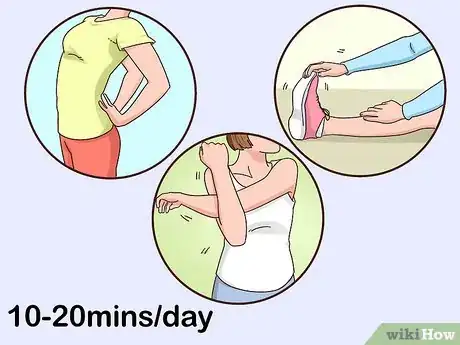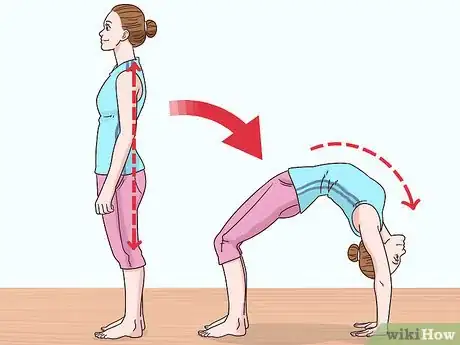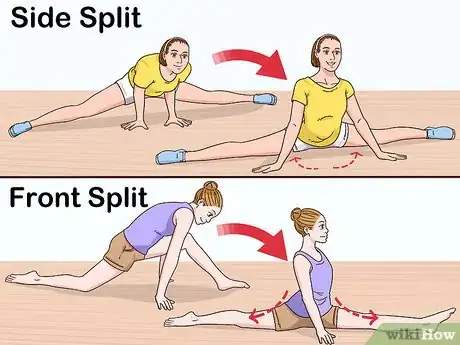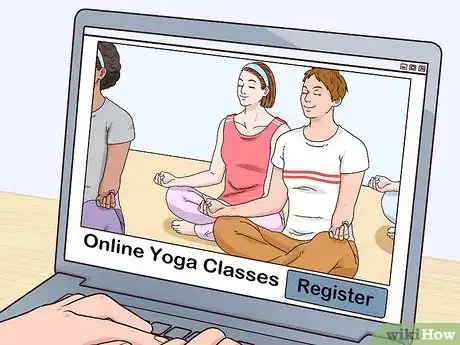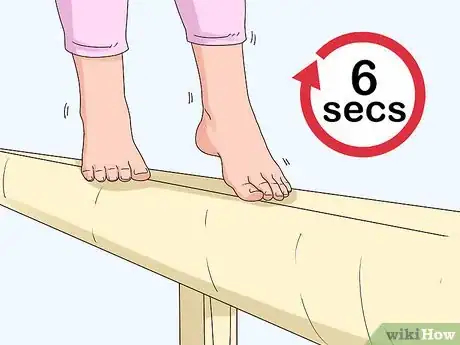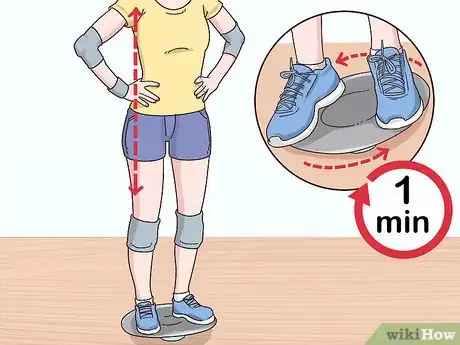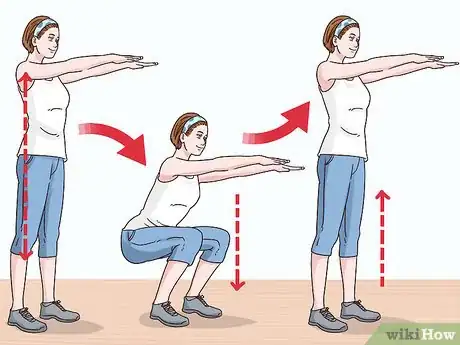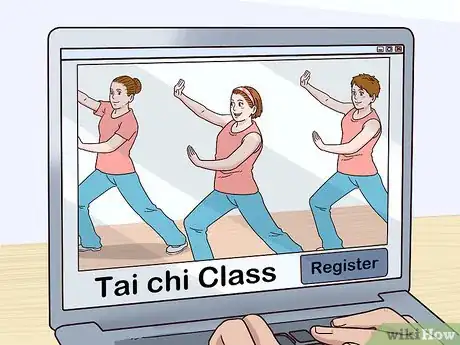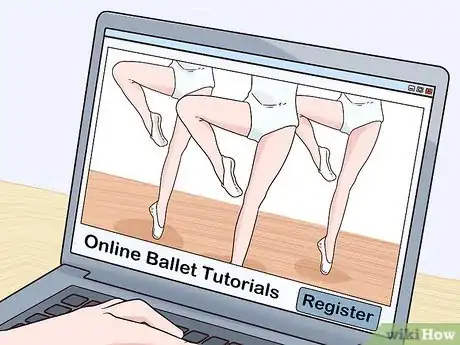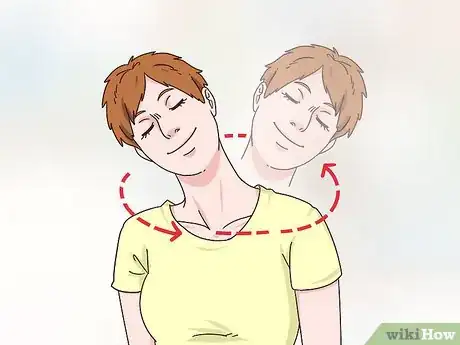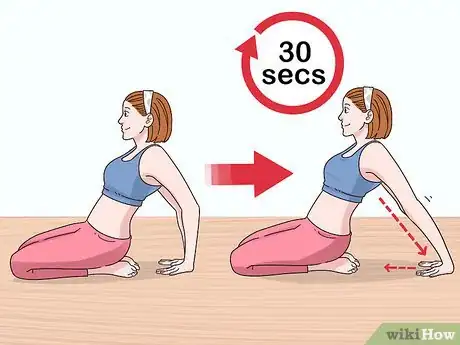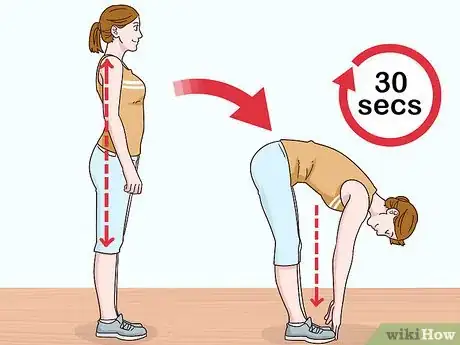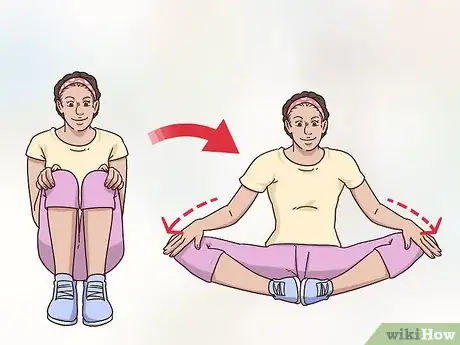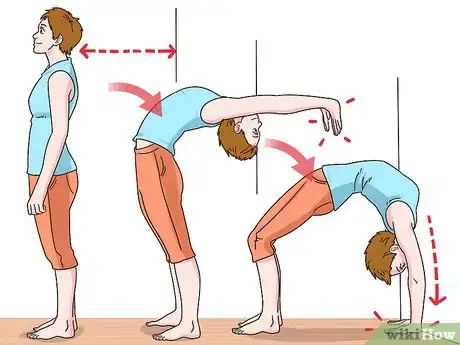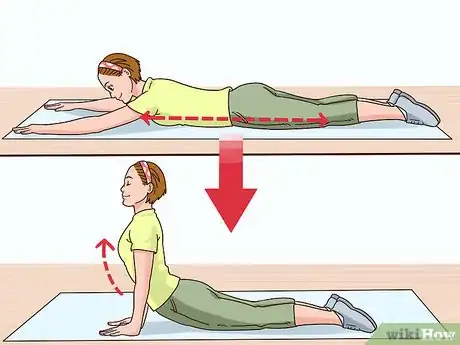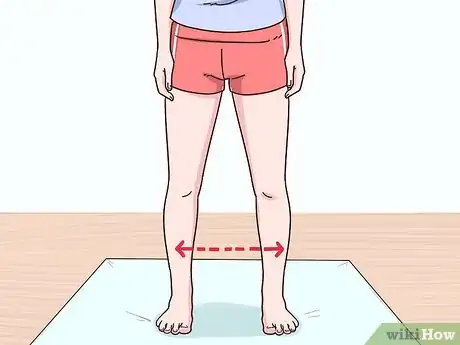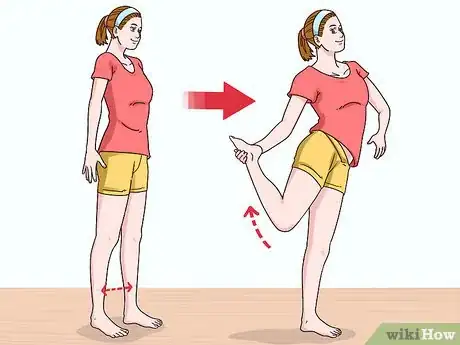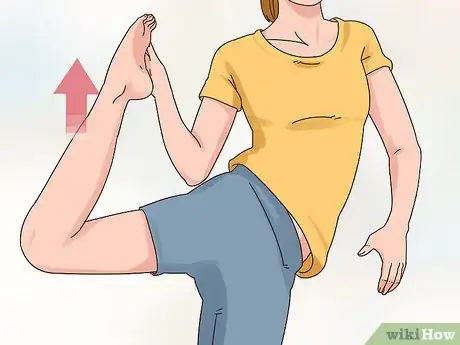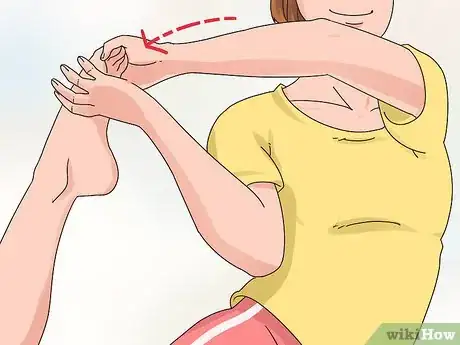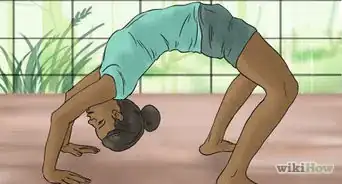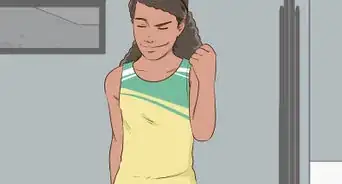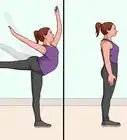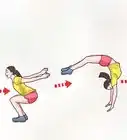This article was co-authored by Eric Christensen, DPT and by wikiHow staff writer, Sophia Latorre. Eric Christensen is a Physical Therapist based in Chandler, Arizona. With over a decade of experience, Eric works in both orthopedic and neurological fields and specializes in custom orthotic prescription and casting, vestibular reprogramming, and manual therapy. He holds a Bachelor’s degree in Exercise Science with a focus in Sports Medicine from Colorado State University and a Doctor of Physical Therapy from Regis University. In practice, Eric takes a developmental approach to rehabilitation utilizing the Selective Functional Movement Assessment. He uses functional movement patterning and manual therapy to return patients to prior levels of function.
There are 14 references cited in this article, which can be found at the bottom of the page.
This article has been viewed 225,055 times.
A scorpion make look like an impossible move, but if you work on your flexibility and balance you’ll be able to accomplish it. Try moves like the backbend and bow, as well as the splits to increase your flexibility. You can also improve your balance by walking the balance beam, standing on one foot, and doing squats.
Steps
Increasing Your Flexibility
-
1Stretch every day. Stretching every day is essential to becoming flexible enough to do a scorpion. Spend 10 to 20 minutes stretching your back, legs, and arms every day. To prevent injury, be sure you begin with gentle stretches before moving into more extreme stretches.
-
2Do a backbend. A backbend is a great exercise to do when you’re working up to a scorpion, which requires an extreme back arch. A backbend stretches your back and is a good warm up. To do one:[1]
- Begin by standing with your legs shoulder-width apart.
- Raise your arms above your head with your hands flat so they are parallel with the ceiling.
- Slowly bend backward and push your thighs forward. Make sure to keep your arms locked as you move closer to the ground.
- Plant your hands and keep your feet firmly in place when you reach the ground. You should be looking in between your hands.
Advertisement -
3Perform a bow stretch. This exercise stretches your back as well as your core muscles. It will help you improve the arch in your back and stomach, which will help you accomplish the scorpion.[2]
- Lay on the ground on your belly and bend your knees so that your toes are pointing toward you. #*Lift your torso off the ground, and reach back to grab your toes. Hold the stretch for 30 seconds, then slowly release it and lower your torso and legs back to the ground.
-
4Work on your splits. Mastering your splits will help prepare you for a scorpion. Practice both the side split and the front split to ensure your legs are as limber as possible.[3]
- For a side split, stand with a wide, straight-legged stance. Spread your legs slightly more than shoulder-width apart, and lower yourself down to the ground.
- For a front split, put one leg out in front of you, and one leg behind you. Place your hands on the floor and slowly slide your front leg forward until your reach the floor, keeping your toes pointed.
- For an additional challenge, when you’re in the front splits, bend your back knee so your foot points toward you. This will help you achieve your scorpion.
-
5Try planks. Plank exercises strengthen your core muscles and improve your balance too. There are tons of variations, so once you get the basics down you can try a side plank or a marching plank.[4]
- Lay flat on the floor on your stomach. Place your palms flat on the ground underneath your shoulders, and flex your feet so that your toes are touching the floor.
- Keep your abs tight and raise your body off the ground, so that your weight is resting on your hands and feet. Be sure to keep your back straight.
- Try to hold the plank for 30 seconds.
-
6Take a yoga class. Doing yoga increases both your balance and your flexibility. Look for a cheap or free class in your area, and sign up. Follow along with the instructor, and ask them to make sure you are using the right technique. You could also get a yoga DVD or follow along with online tutorials.[5]
Improving Your Balance
-
1Walk the balance beam. A great way to improve your balance is to use a balance beam. Walk along the beam and practice keeping your center of gravity over the beam. Keep practicing until you no longer need to hold your hands out for support and can walk the entire length of the beam in under 6 seconds.[6]
-
2Stand on one foot. Work up to balancing on one foot for a minute. Use a little support if needed. Then switch, and balance on the other foot. It’s important to exercise both sides so that one side doesn’t become weaker than the other.[7]
-
3Use a wobble board. Stand on the board with your feet shoulder-width apart. Tighten your abs and rock backward, forward, and side to side. This will help you keep your balance, and prevent you from falling, while doing a scorpion. Keep trying until you can balance for one minute or longer.[8]
-
4Do squats. Stand with your hips and knees apart, your arms out, back straight, and abs tight. Bend your knees and hips, slowly lowering yourself until your thighs are parallel to the floor. Rise back up slowly, squeezing the muscles in your backside. Repeat the desired number of times.[9]
-
5Take a tai-chi class. Those who do tai-chi have incredible strength and balance. Do an Internet search to find a class in your area, or look for a personal instructor. Focus on your breathing and balance while following along with the moves.[10]
-
6Take up ballet. Ballet dancers also have amazing balance. Find online tutorials and videos, or sign up for a ballet class. Not only will you improve your balance, you’ll also increase your flexibility and learn new moves.[11]
Warming Up Before a Scorpion
-
1Do neck rolls. Stretch out your neck to avoid kinking it when you do the scorpion. Gently tilt your head to one side then roll it down in a circular motion, sweeping from one side, toward your chest, then to the other side. Then, roll your neck back so you are looking up at the ceiling or sky, and sweep it back to the starting position.
-
2Stretch your shoulders. It’s important to stretch your shoulders and upper chest so you can reach your foot to complete the scorpion. Sit on the floor and put your arms behind you with your fingers facing the rear. Straighten your arms as you slide your hands away from your body. Hold for 30 seconds, then slowly walk your hands forward.[12]
-
3
-
4Do a straddle stretch. Start by sitting on the ground with your legs spread out in front of you. Open your legs as wide as you can but keep your knees and legs straight. Keep your back straight and lean over to one side to touch your toes. Repeat on the other side.[16]
- You can also reach out in front of you with your arms and try to touch the ground.
-
5Do a butterfly stretch. Sit on the ground and bend your knees to the sides so that the bottoms of your feet are touching. Gently press down on your knees to stretch your hips. You can also lean over and reach your arms out in front of you so that they touch the floor.[17]
-
6Try a wall bridge. Stand a few feet away from the wall and place your hands on the wall behind your head by bending backward. Walk yourself down to the ground.[18]
-
7Rock out your back. Lay on your back and bring your knees in toward your tummy. Hold your legs with your arms so that you are curled up in a ball. Rock back and forth to stretch your back muscles.[19]
-
8Do a seal stretch. Lay flat on your tummy then use your arms to hold your torso up. Tip your head back. This stretches your chest, abdominal, and back muscles. A snake or cobra stretch is another name for this pose.[20] [21]
- If that stretches your muscles too far, support your body with your elbows and forearms and work up to using your hands to support your weight.
Trying the Scorpion
-
1Stand with your legs slightly apart. You should be facing forward, with your arms at your sides. If you are attempting the scorpion for the first time, you may want to have a spotter there to assist you, or stand near a dresser or other flat, stable surface you can use for balance.
-
2Grip the outside of one of your feet with the hand on the same side. Bend your leg backward at the knee so that you can reach your foot. Use the hand on the same side of your body to grip your foot (e.g., if you are bending your left leg, grip it with your left hand). Keep the knee on your other leg locked for stability.
-
3Push your leg up behind you. Use your leg muscles to stretch your leg as high as it will go behind you. Don’t use your hand to pull your muscles, just use it to guide your foot into the correct position.
-
4Turn your elbow outward. As your leg raises higher, turn the elbow on the hand gripping your foot outward so that it points forward, in front of your head.
-
5Grip your foot with your other hand. Reach behind you and grab your foot with your other hand, so that both hands are now holding your foot. Your elbows should be above your head, pointing in front of you.
-
6Push your leg higher. Try to push your leg as high as it will go. This is the scorpion.
-
7Use a sports band to practice. If you can’t quite reach your toes yet, use a sports band to help you stretch. Hold the band in both hands behind your legs like you would with a skipping rope. Put the band around the top of one foot (near your toes) and pull your leg up behind you.
Community Q&A
-
QuestionDo I need to go see someone if my child can't stretch like that?
 Community AnswerNo, everyone is different. It takes time to develop some skills.
Community AnswerNo, everyone is different. It takes time to develop some skills. -
QuestionHow do you get the bandana to stay on your foot?
 Nico RobiniolCommunity AnswerTwo options: make a little "hook" with your foot or tie the bandana to your foot.
Nico RobiniolCommunity AnswerTwo options: make a little "hook" with your foot or tie the bandana to your foot. -
QuestionI don't need the sports band or rope, do I?
 Community AnswerIt isn't necessary, but some people find using a sports band or rope helpful. It's still possible to do a scorpion without using those, but everyone is different.
Community AnswerIt isn't necessary, but some people find using a sports band or rope helpful. It's still possible to do a scorpion without using those, but everyone is different.
References
- ↑ https://snapguide.com/guides/do-a-back-bend-like-a-gymnast/
- ↑ https://www.doyouyoga.com/how-to-do-bow-pose/
- ↑ https://breakingmuscle.com/fitness/you-can-already-do-the-splits-how-to-relax-into-stretch
- ↑ http://www.health.com/health/gallery/0,,20813896,00.html
- ↑ http://www.prevention.com/fitness/fitness-tips/6-ways-improve-your-balance
- ↑ http://www.topendsports.com/testing/tests/balance-beam.htm
- ↑ https://www.sharecare.com/health/fitness-exercise/article/improve-your-balance
- ↑ http://www.prevention.com/fitness/fitness-tips/6-ways-improve-your-balance
- ↑ https://www.nerdfitness.com/blog/strength-training-101-how-to-squat-properly/
- ↑ http://www.prevention.com/fitness/fitness-tips/6-ways-improve-your-balance
- ↑ http://www.prevention.com/fitness/fitness-tips/6-ways-improve-your-balance
- ↑ http://healthyliving.azcentral.com/gain-flexibility-gymnast-8326.html
- ↑ Eric Christensen, DPT. Physical Therapist. Expert Interview. 17 March 2021.
- ↑ http://woman.thenest.com/gain-flexibility-gymnast-6649.html
- ↑ Eric Christensen, DPT. Physical Therapist. Expert Interview. 17 March 2021.
- ↑ http://woman.thenest.com/gain-flexibility-gymnast-6649.html
- ↑ https://www.thoughtco.com/butterfly-stretch-1007329
- ↑ http://woman.thenest.com/gain-flexibility-gymnast-6649.html
- ↑ http://www.stretching-exercises-guide.com/back-stretches.html
- ↑ http://www.yinyoga.com/ys2_2.0_asanas_sphinx_seal.php
- ↑ Eric Christensen, DPT. Physical Therapist. Expert Interview. 17 March 2021.
